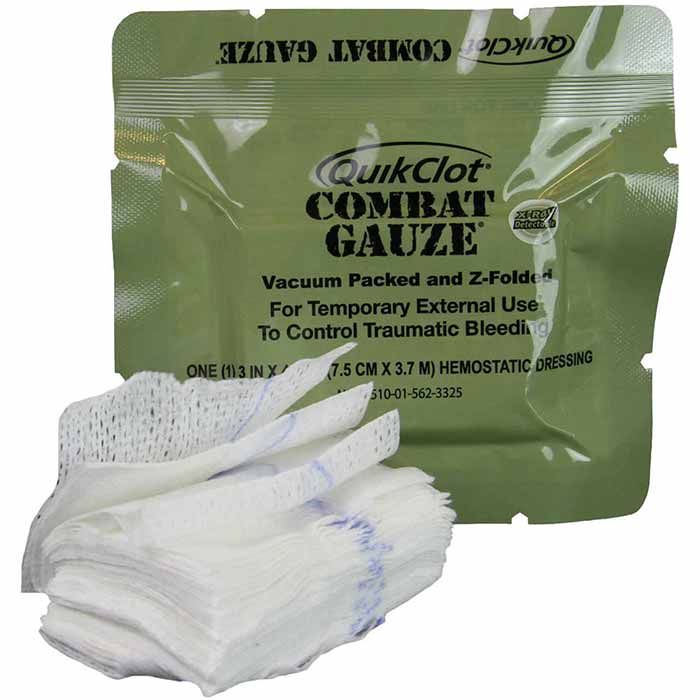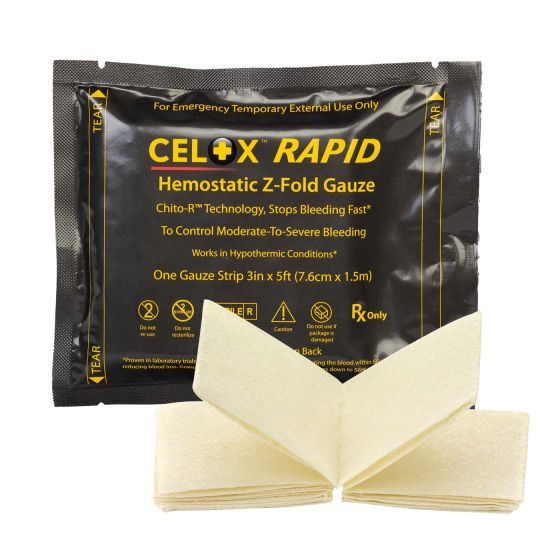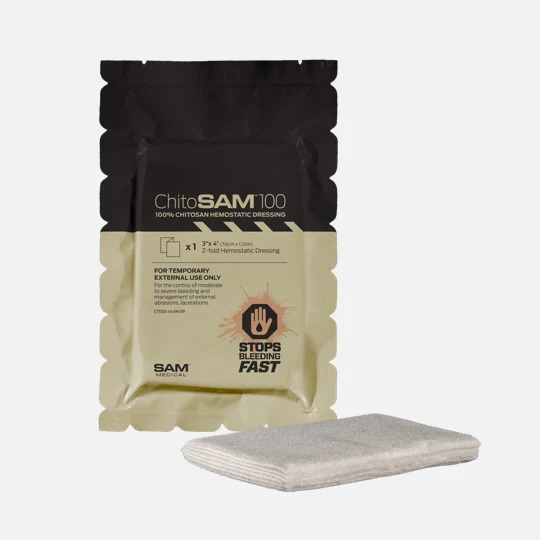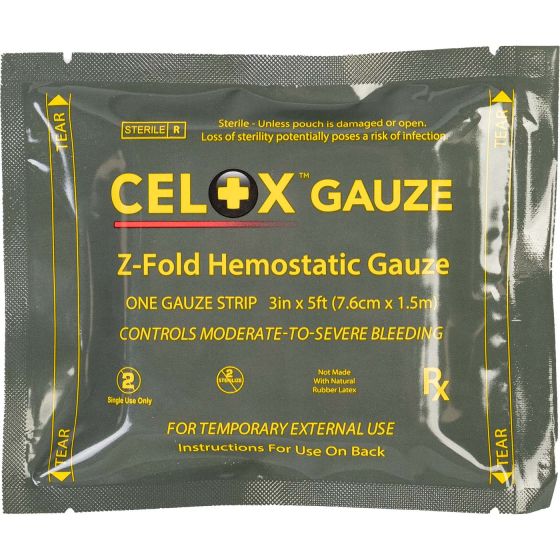Hemostatic bandages: an effective means of stopping bleeding in combat conditions
Content

Bleeding is one of the most common and dangerous injuries on the battlefield. If timely assistance is not provided, blood loss can lead to shock, infection, and death. Therefore, it is important to have an effective means of stopping bleeding that can be quickly and easily applied in extreme conditions. Such a tool is a hemostatic bandage.
A hemostatic bandage is not just an ordinary bandage, but a true lifesaver that contains a special substance that stops bleeding within minutes. It allows for effective control of bleeding from various sources, even from major arteries, and also prevents infection and reduces the risk of complications. Lightweight, compact, and easy to use, making it ideal for combat situations.
In this article, we will tell you about the hemostatic bandage: what it is, how it works, and how to use it to stop bleeding. We will also reveal to you the secrets of tamponade - a special technique that allows stopping bleeding from deep wounds.
What is a hemostatic bandage?
A hemostatic bandage is a special bandage that contains an active substance that promotes blood clotting. This substance can be various: kaolin, chitosan, fibrin, alginate, etc.
A hemostatic bandage is applied to the wound and compresses it to reduce blood flow and create an artificial clot.
It can stop bleeding from arterial, venous, and capillary vessels, as well as from wounds of internal organs. The hemostatic bandage is an indispensable element of a fighter's individual first aid kit, which can save his life or the life of a comrade.
Also, a hemostatic bandage can be useful for medical workers, rescuers, tourists, athletes, and anyone who may find themselves in a situation where bleeding needs to be stopped quickly.
If you are looking for a quality and reliable hemostatic bandage, we recommend our product - QuickClot Combat Gauze hemostatic bandage.

This bandage has the following advantages:
- Made from high-quality cotton that doesn't irritate the skin and doesn't leave lint on the wound.
- Contains kaolin - a natural mineral substance that activates blood clotting and doesn't cause allergies.
- Doesn't cause irritation or burns.
- Recommended by the TCCC committee for stopping bleeding.
- Included in the arsenal of the US Army.
- Has a radiopaque strip for ease of use and localization.
- Provides bleeding control in just 3 minutes.
- Has optimal length and width to cover wounds of any size and shape.
- Has convenient packaging that protects the bandage from contamination and ensures sterility.
How to use
QuickClot Combat Gauze hemostatic bandage can be used to stop bleeding from any part of the body.
Here's a general instruction on how to do it:
- Open the bandage package and pull it out.
- Find the source of bleeding and apply the bandage with the white side to the wound. The white side contains kaolin, which promotes blood clotting.
- Secure the bandage around the wound by making several wraps. Do not stretch the bandage too tightly to avoid constricting blood vessels.
- Secure the end of the bandage with adhesive tape, pins, or a knot.
- Check if the bleeding has stopped. If not, apply another bandage over the first one.
- If the bleeding has stopped, leave the bandage on the wound until medical help arrives or until you can see a doctor.
- If the wound is in deep tissues, such as the abdominal cavity, tamponade may be necessary.
Packing
Packing is the process of filling a wound with a hemostatic bandage to apply pressure on the vessels and stop bleeding. Packing can be dangerous if done incorrectly, so the following steps should be followed:
- Open the bandage package and pull it out.
- Locate the source of bleeding and apply the bandage with the white side to the wound. The white side contains kaolin, which promotes blood clotting.
- Using fingers or a tool (such as tweezers), start packing the bandage into the wound, moving from the edges to the center. Do not leave gaps between layers of the bandage. Avoid touching the wound directly with your hands to prevent infection.
- Fill the wound with the bandage completely, but do not overpack it to avoid causing additional bleeding.
What to do if bleeding control is lost
Sometimes a hemostatic bandage may not stop bleeding, especially if the wound is large, deep, or located on important arteries. In such cases, swift and decisive action is necessary to prevent fatal blood loss.
Here's what to do:
- Do not remove the hemostatic bandage from the wound; instead, apply another one on top of it. This will help increase pressure on the wound and reduce blood flow.
- If the bleeding is coming from a limb, try raising it above the level of the heart to reduce blood flow to the wound.
- If the bleeding is from a major artery, such as the groin, collarbone, or armpit, try pressing on it with a finger or palm to block the blood flow. This may be painful but effective.
- If the bleeding doesn't stop even after applying a hemostatic bandage and pressure on the artery, you can use an additional measure - a tourniquet.
Remember!
QuickClot Combat Gauze hemostatic bandage is an effective means to stop bleeding in combat situations, but it does not replace medical assistance. Therefore, after applying the bandage, it is important to seek medical attention from a doctor or healthcare professional as soon as possible to receive proper treatment and infection prevention.
Additionally, it is important to follow these safety and disinfection recommendations:
- Store the hemostatic bandage in a dry and clean place, protected from light and heat.
- Do not use the hemostatic bandage after the expiration date indicated on the packaging.
- Do not use the hemostatic bandage if the packaging is damaged or opened.
- Do not use the hemostatic bandage if it is dirty or wet.
- Do not reuse the hemostatic bandage; discard it after single use.
- Do not use the hemostatic bandage if you are allergic to kaolin or other components of the bandage.
- Do not use the hemostatic bandage if you have hemophilia or other blood clotting disorders.
- Do not use the hemostatic bandage if you are taking anticoagulants or other medications affecting blood clotting.
- Do not use the hemostatic bandage if you are pregnant or breastfeeding.
QuickClot Combat Gauze hemostatic bandage is a modern and effective means to stop bleeding in combat conditions, which can save lives in extreme situations.
However, it is not a cure-all for all injuries and does not replace medical assistance. Therefore, it should be used wisely and responsibly, following the instructions and advice provided in this article.
Be cautious and protect yourself and your comrades!



